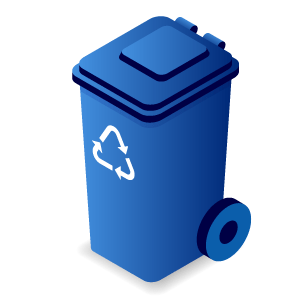Paper recycling: how to recycle paper at home?

Paper is one of the easiest materials to recycle. By sorting used paper and throwing it in the proper recycling bin, you preserve the planet's forests and natural resources. In this guide, we explain how to correctly recycle your paper waste, and reveal the benefits to the environment when you do.
I stand up for real climate action, I offset my CO2 emissions!Global warming is everyone's business! To offset your CO2 emissions and participate in the energy transition.
Send us an e-mail
How to recycle paper?
Like cardboard recycling, paper recycling is very simple. Indeed, paper is made from vegetable fibres, generally obtained from wood. Called cellulose, these fibres are biodegradable, recyclable and not harmful to health or the environment.
What is recycling?Recycling is the process in which waste is converted into reusable material. Many items in our homes can indeed be recycled, including glass, aluminium, plastic, and clothing.
Paper recycling bin: What kind of paper is recyclable?

Most councils in the UK provide kerbside recycling collections of various materials, including paper. Depending on where you live, your paper recycling may be collected as just paper and cardboard recycling, or as part of the mixed recycling collection. In most cases, paper recycling goes in the blue bin, but that too can vary depending on the procedures in place at your local council. Should you have any doubts, your best bet is to contact your council and ask.
Paper items that can be included in the recycling bin include:
- Newspapers and supplements;
- Magazines, brochures and catalogues;
- White paper (e.g. computer paper, letters);
- Telephone directories;
- Junk mail and flyers;
- Envelopes (including those with a window).
If you do not have access to a blue bin at home for kerbside recycling collections, there are other ways you can recycle your paper. You can take it to recycling centres run by your local council. Buildings with a high footfall, such as supermarkets, sports centres and shopping centres, often have recycling containers for various items. If you are unsure where your nearest paper recycling bin is, you can search online for ‘paper recycling near me’ to get more information.
Brown paper recycling: What to do with it?Brown paper, used for parcel packaging or envelopes, can be put in your recycling container as normal.
Paper towel recycling: Can that be recycled?Unlike brown paper, paper towels can not be recycled because their fibers are usually too short to be used again. Some councils allow a very small amount of kitchen towel to be used at the bottom of the food waste bin, but not all, so you should check first.
Shredded paper recycling: can you put shredded paper in the recycling bin?
There are, however, some paper items that can not be put in the recycling bin. One of these is shredded paper. This is because paper mills can’t process it as the pieces are too small. Instead, you have many options to recycle your shredded paper, including:
- Add it to your home compost as part of your composting. Paper is not harmful to plants, and will break down easily;
- Put it at the bottom of your food waste bin to soak up any liquids and prevent dripping;
- Take it to a paper bank, where it can be disposed of safely.
Tissue paper recyclingJust like shredded paper, tissue paper can not be placed in the paper recycling bin. This is because the fibres used in it are very short, meaning that when recycled, it would not make good quality paper. However, tissue paper will break down, so you can add it to your home composting.
How do businesses recycle paper?
Recycling paper has been at the forefront of people’s minds for a long time. For many years, many businesses, companies, and organisations across the UK have encouraged employees and clients to reduce the paper usage with messages such as ‘Don’t print this email’.
However, businesses today still need solutions to recycle large amounts of paper waste. There are many private companies in the UK, such as Biffa, that specialise in commercial waste removal. Normally, they will remove waste and recycling items from the business premises and take care of the recycling process.
Paper recycling sign
To be aware of what items can be recycled, many products have logos to help resolve any doubts. In the table below, you can see the most common recycling logos on all sorts of items in the UK, including paper.
| Symbol | Meaning |
|---|---|
|
Mobius Loop 
|
This symbol is widespread and used on many items. It indicates that the packaging is recyclable. |
|
The Green dot 
|
The packaging producer has made a contribution towards packaging recycling. Be aware though, it does not necessarily mean the packaging itself is recyclable. |
|
Widely recycled 
|
For an items to be considered 'widely recycled' it must be collected by at least three quarters (75%) of local authorities across the UK. It can be used on a number of recyclable items, including glass, plastic, paper, and cardboard. |
|
FSC 
|
The Forest Stewardship Council logo is on all packaging or products which contain wood from well managed forests. |
|
Corrugated recycles 
|
Developed by the International Corrugated Case Association, this logo indicates that corrugated cardboard and paper packaging can be recycled. |
The recycling process of paper: How is paper recycled?
The paper recycling process is fairly straightforward and is very efficient. With the advancements in technology, the processes will get even easier in the future, allowing for more paper to be recycled, and prevent issues such as deforestation.
In brief, there are five key steps in the paper recycling process. They are the following:
- Collection: Paper is collected as part or the kerbside collection run by your local council, or the paper recycling containers emptied from outside supermarkets or from recycling centres.
- Sorting and recycling: Once at a paper mill, the paper is sorted into different types and grades. It then undergoes a process of washing to remove any items that could contaminate in the recycling process, such as paint, glue, and ink.
- Pulp: The paper is left in water. When wet, paper becomes soggy and breaks down into a substance known as pulp.
- Rolling: The pulp is then pressed and left to dry, before it is rolled into large sheets of recycled paper. In some cases, these rolls can be as long as 50 miles.
- Ready for reuse: The rolls of paper are now ready to be cut to size and used for various items such as newspapers, books, magazines, etc.
The benefits of paper recycling
Recycling paper waste is an easy action to take at home but has a big impact on the environment and our collective efforts to tackle climate change. Some of the key advantages of recycling paper are:
- It saves water and energy;
- Reduces soil contamination;
- Contributes to reducing the amount of waste and the cost of treating it;
- Fight against deforestation by protecting the forest resources that are used to make paper;
- Limits carbon dioxide (CO2) emissions linked to the extraction of new natural resources, such as water or wood, necessary for the manufacture of paper.
Thus, paper recycling contributes to the reduction of waste and prevents the depletion of natural resources. It also contributes to the fight against global warming by limiting greenhouse gas emissions due to the extraction of new natural resources.
Facts about recycling paper in the UK
To understand the importance of recycling paper and the impact it can have on the environment, here are some facts about paper recycling:
- More than 9.9 million tonnes of paper is used in the UK every year, with around 80% of that being recycled;
- Paper is one of the most recycled items in the UK;
- Each year, the average UK household will use around 6 trees worth of paper;
- In total, Britons throw away 227,000 miles of wrapping paper every Christmas. That amount of wrapping paper would be enough to cover roughly 11,000 football pitches.
- Recycling paper has a huge impact on reducing the need to use the earth’s natural resources - for every tonne of paper recycled, 380 gallons of oil is saved, along with 7,000 gallons of water, and around 3 cubic metres of landfill space.
Source: Recyclingbins.co.uk.
- Discover all our other guides on recycling
- Aluminium recycling: How and why to recycle it?;
- Glass recycling: Your guide on how to recycle glass items;
- Composting: What is it and how to start?;
- Clothing recycling: How to recycle old clothing?;
- Plastic recycling: Your guide on what plastics can be recycled;
- Cardboard recycling;: Your guide on how to recycle cardboard
- Tyre recycling: Where to dispose of them?.
